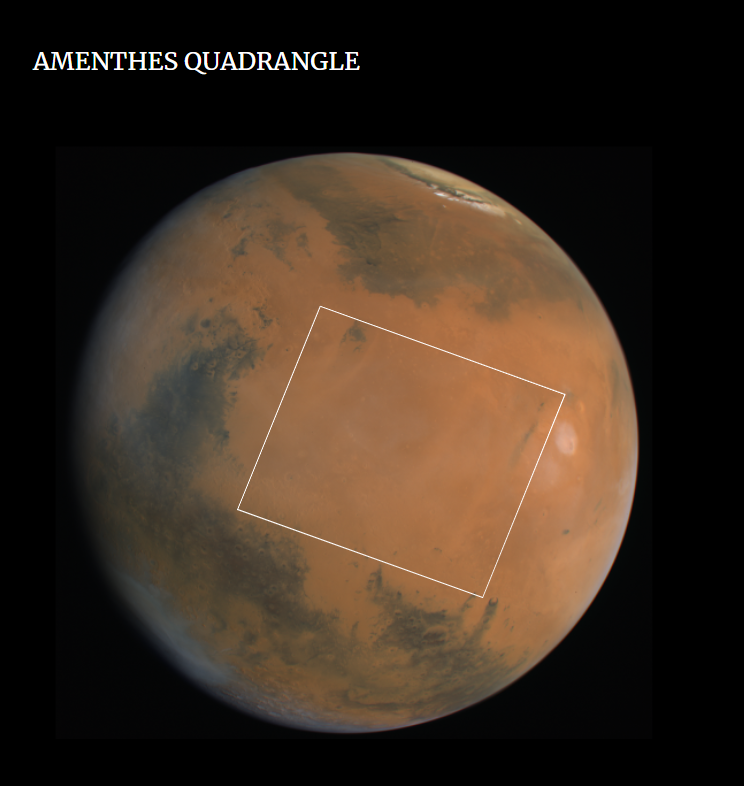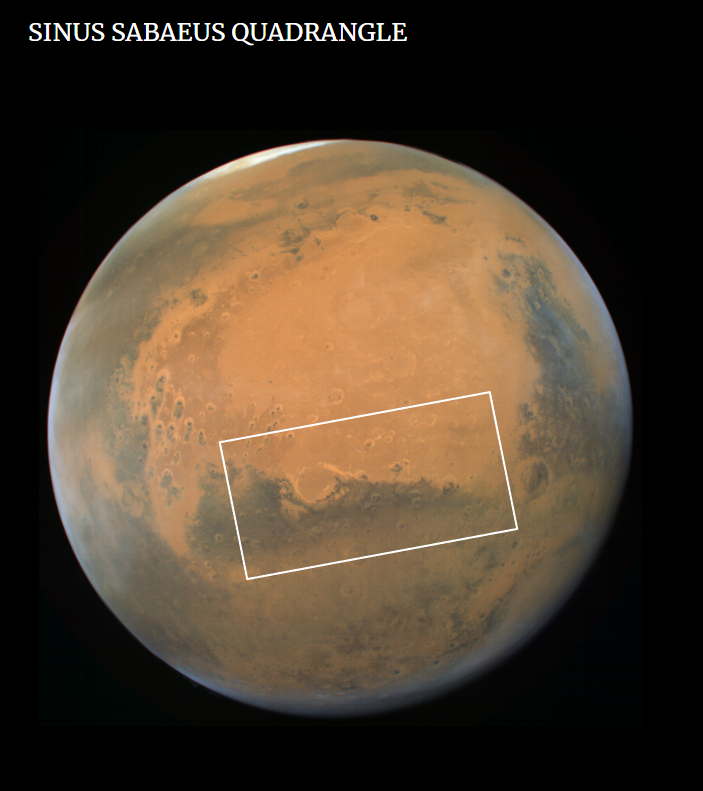The United States Geological Survey has split Mars' surface into thirty cartographic quadrangles. Each quadrangle is an area on the Martian surface that covers a certain range of latitudes and longitudes. The quadrangles are numbered from one to thirty, with the prefix "MC" (for "Mars Chart"), and the numbering runs from north to south and west to east.
07-02-2021 | Orbit: 74
Mare Boreum:
Mare Boreum quadrangle, whose name is derived from the older name for the northern polar plain Planum Boreum, is located north of the 65° latitude. The North polar cap is a distinct feature of this quadrangle and it is surrounded by plains Planum Boreum and Vastitas Borealis, which is the largest lowland region on Mars. Around the cap there is a belt of sand dunes, which is possibly the largest dune field in our Solar System. Chasma Boreale is a valley close to the pole that could have been formed by melting of the ice from the North polar cap. Prominent craters of the region are Lomonosov and Korolev, which are unique in the northern region because there is not much change in topography.
08-16-2021 | Orbit: 94
Ismenius Lacus:
The origin of the name of the quadrangle comes from the Latin for the Ismenian Lake, which refers to springs close to Thebes in Greece. Ismenius Lacus can be found in the eastern hemisphere of Mars. This quadrangle contains segments of these plains: Acidalia Planitia, Arabia Terra, Vastitas Borealis, Terra Sabaea, Deuteronilus Mensae, and Protonilus Mensae. In the latter two regions, glaciers persist in the current times. Many channels have been found near Lyot Crater, which is the largest crater in the quadrangle.
Arabia:
Italian astronomer Giovanni Schiaparelli named the region after the Arabian peninsula. The Arabia quadrangle lies in the northern hemisphere on the boundary of the northern lowlands and southern highlands. The quadrangle includes a part of Arabia Terra which is a large upland region. It also contains a part of Terra Sabaea and a small part of Meridiani Planum. The area is characterized by extensively cratered highlands, notably Cassini Crater in the northeast.
07-09-2021 | Orbit 77
Amazonis:
Amazonis Planitia, named after the Amazonian Epoch, is one of the youngest regions of Mars. Craters rarely occur in the Amazonis quadrangle. The Medusae Fossae Formation and Sulci are unique features found in this area.
Memnonia:
A quadrangle with several ancient river valleys like Mangala Vallis, Memnonia is a cratered highland terrain with varying degrees of crater degradation. The wall and floor of one of the more prominent features, Columbus Crater, were discovered to be made up of layered sedimentary rocks. It is believed that water may have been involved in deposition of these layers due to the presence of trace hydrated minerals.
08-09-2021 | Orbit 91
Tharsis Quadrangle:
The Tharsis is a biblical name for a land described in the Bible, near the historic town of Tartessus. It is located in the western hemisphere of Mars. This region contains Tharsis rise, which is the birthplace of three of the four largest shield volcanoes on Mars: Olympus Mons, Ascraeus Mons, and Pavonis Mons. Another interesting feature is Ceranius Fossae which is located in the north central part of the quadrangle.
06-13-2021 | Orbit: 66
Syrtis Major Quadrangle:
The quadrangle is named after a Latin translation for the Gulf of Sidra on the coast of Libya. Syrtis Major quadrangle consists of Syrtis Major Planum, and parts of Terra Sabaea and Isidis Planitia. It is a distinct dark region on the Martian surface. Distinctive features are calderas Meroe Patera and Nili Patera, The calderas' floors are unusual among major Martian volcanoes in that they are not raised over the surrounding topography. Mars 2020 rover (Perseverance and Ingenuity) landed at the Jezero crater in February 2021.
08-02-2021 | Orbit: 88
Amenthes Quadrangle:
Named after the Ancient Egyptian term for the location where souls of the deceased go, the Amenthes quadrangle contains Utopia Planitia, Isidis Planitia, Terra Cimmeria, and Tyrrhena Terra. Mars Reconnaissance Orbiter found traces of magnesium carbonate in the Isidis basin, which suggests the water was once present in the area was not acidic.
07-04-2021 | Orbit: 75
Sinus Sabaeus:
The name derives from a region Southern Arabian Peninsula that is rich in incense (the Gulf of Aden). The quadrangle is home to Schiaparelli, a massive, plainly visible crater near the equator. Parts of Noachis Terra and Terra Sabaea make up the Sinus Sabaeus quadrangle.
08-14-2021 | Orbit 93
Iapygia:
This quadrangle contains the areas of the Tyrrhena Terra and Terra Sabaea regions. Huygens is the quadrangle's biggest crater. Dikes, sheets of rock formed in a fracture of a pre-existing rock body, carbonates on the rim of Huygens and the strata formed as a result are quadrangle's most intriguing features.








